Traditional European tortes are usually rich and elaborate cakes and as such they are normally prepared just for a very special occasion. Recalling from my childhood memories, in our family that was just for our birthdays. Only other rare event that would land a piece of torte on our plate was possibly a wedding or a birthday party, and those were far and few between. That was it!
Another thing was: For torte to be impactful and respectful it had to be made with nuts! Most often that was with walnuts and less commonly with almonds or hazelnuts. That was unspoken rule! The cake sponge was flourless and that meant large number of eggs in the recipe. From these few typical and simple ingredients many great recipes were created, and the Shubert’s Torte is just one of them!
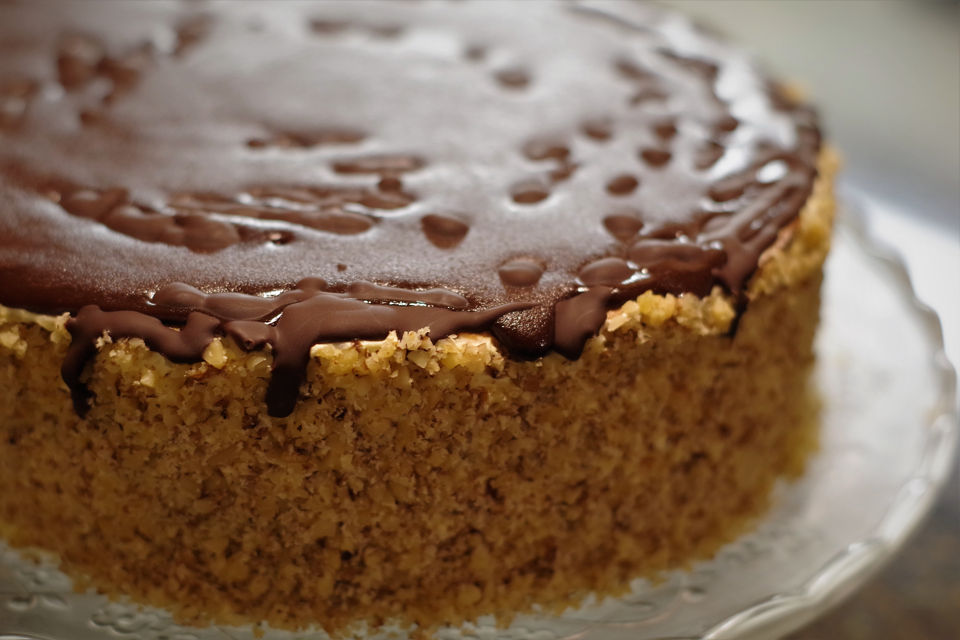
The recipe for this this torte has been adapted from my family heirloom cookbook :”The Great National Cookbook” (“Велики Hародни Kувар”). I wanted to make this cake for a long time, ever since I first time read through the cookbook’s cake register, although I am not entirely sure why? At first look the recipe sounded as a typical walnut and chocolate based torte and there are countless number of such recipes. Pretty much each family has its own, and they are all good! So why this one? It could have been its catchy name, or a sponge combination involving two kinds of nuts, walnuts and almonds, which was little unusual, or maybe it was an apricot glaze which was also unusual for Balkan style nut torte?
I don’t know, but whatever the decision driver was, I am quite happy I did make it and it did not disappoint! The occasion was right too: it was my birthday!
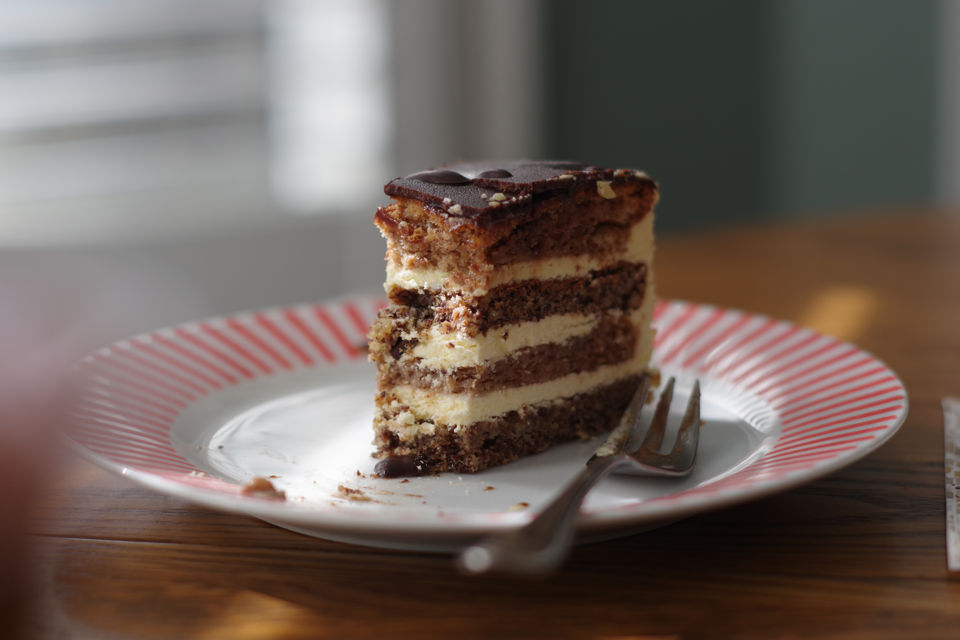
The torte has a rich nutty flavor beautifully balanced with sweet and buttery pastry cream. However, there is one very important factor to take into account: for the best taste experience I highly recommend that you make the cake about 3 days ahead, and serve it tempered, at room temperature. This will make a dramatic difference, trust me! It takes a few days for all the flavors to unify, and by then, all you will end up with is a smooth cake texture infused with heavenly nutty aromas.
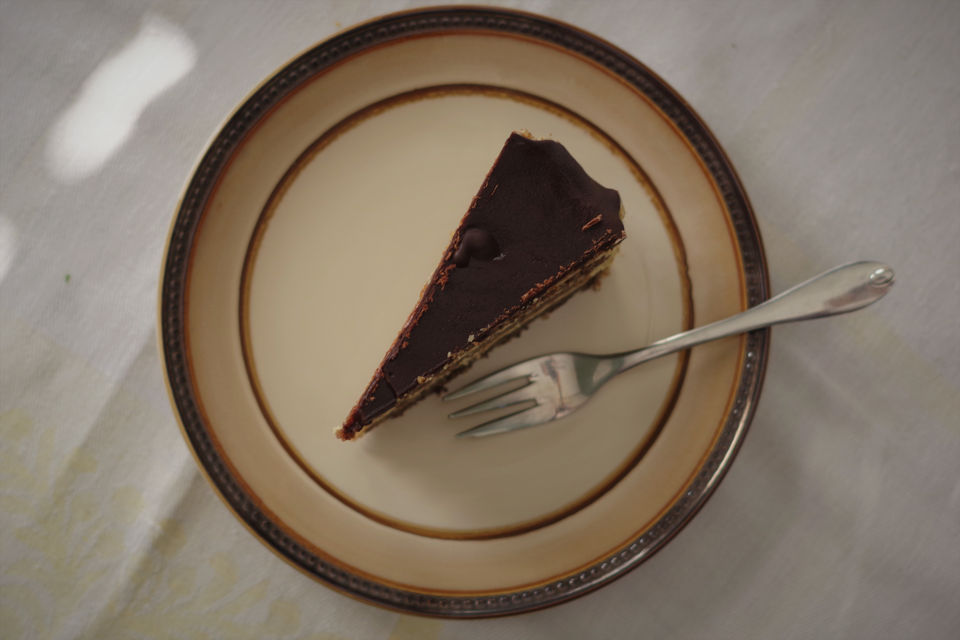
As it is the case with most of the recipes in this old cookbook, this recipe also required some “decoding” and “filling in the blanks”. The chocolate glazing I used was the same recipe as for Leschanz Sachertorte and Srneca Ledja.
The original recipe called for a simple apricot jam, but instead, I enhanced it by making an apricot glaze.
It is an outstanding cake worthy of every special occasion!

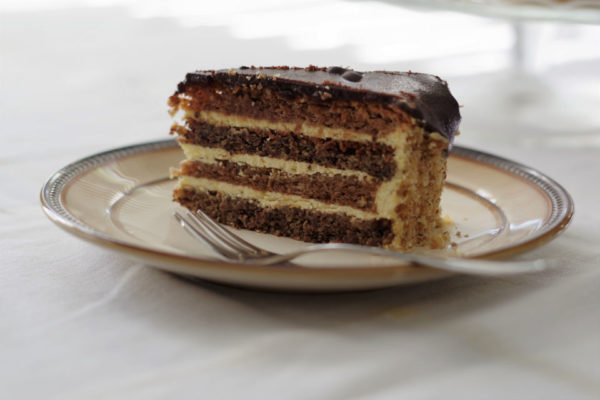
| Prep Time | 1.5 hours |
| Cook Time | 1.5 hours |
| Passive Time | 2 hours |
| Servings |
servings
|
- 100 g unsalted butter softened
- 4 large eggs separated and at room temperature
- 70 g granulated sugar divided
- 80 g ground whole almonds
- 60 g dark semisweet chocolate (min. 70% cocoa) grated
- 1/8 tsp cream of tartar
- 1 large egg at room temperature
- 4 egg whites at room temperature
- 100 g granulated sugar divided
- 80 g ground walnuts
- 20 g dried bread crumbs or ground cookie crumbs
- 4 egg yolks
- 100 g granulated sugar divided
- 1/2 cup heavy cream 35% MF
- 1 tsp pure vanilla extract
- 140 g unsalted butter softened
- 1/2 cup apricot preserves
- 2 tsp golden Rum or water
- 60 g dark semisweet chocolate (min. 70% cocoa)
- 1/2 cup granulated sugar
- 1/4 cup water
- 100 g chopped walnuts
Ingredients
Chocolate Almond Sponge Cake
Walnut Sponge Cake
Pastry Cream
Apricot Glaze
Chocolate Glaze
Decoration
|

|
- Butter and line the bottom of 9" springform baking pan with parchment paper.
- Preheat the oven to 180ºC (355ºF), rack in the middle.
- Using a hand held mixer and a medium size mixing bowl, beat together butter and 1/2 of granular sugar, at high speed, until creamy and fluffy, about 8-10 minutes.
- Maintaining high speed add and mix in one egg yolk at the time.
- Using a balloon whisk or mixer at low speed mix in ground almonds and grated chocolate.
- In a large bowl, beat the egg whites with cream of tartar until soft peaks form. Gradually add remaining 1/2 of granulated sugar and beat until stiff, shiny peaks form.
- Using a silicone spatula take about 1/4 of egg whites and mix into the butter mixture, lightening it up. Fold in the rest of the egg whites. Use a scooping motion from the outside towards the middle of the mixing bowl. Try not to overdo it and deflate the egg whites!
- Spread the batter evenly into the springform baking pan and bake for 30-35 minutes, until golden brown. The cake top should spring back when pressed lightly in the middle.
- Transfer the baking pan to a cooling rack and let it cool for 5 minutes.
- Remove the sides of the pan, invert cake onto the flat plate, remove the parchment paper. Reinvert the cake onto the rack, right side up. Let it cool completely.
- Preheat the oven to 180ºC (355ºF), rack in the middle.
- Butter and line the bottom of 9" springform baking pan with parchment paper.
- Mix together ground walnuts and dried bread crumbs. This will prevent walnuts from forming clumps.
- Combine the whole egg, egg yolks and 1/2 of sugar in a medium size mixing bowl. Beat with mixer on high speed until pale yellow and creamy, about 8-10 minutes.
- Using a balloon whisk or mixer at low speed mix in the ground walnuts mixture.
- In a large bowl, beat the egg whites with cream of tartar until soft peaks form. Gradually add remaining 1/2 of granulated sugar and beat until stiff, shiny peaks form.
- Using a silicone spatula take about 1/4 of egg whites and mix into the butter mixture, lightening it up. Gently fold in the rest of the egg whites.
- Spread the batter evenly into the springform baking pan and bake for 30-35 minutes, until golden brown. The cake top should spring back when pressed lightly in the middle.
- Transfer the baking pan to a cooling rack and let it cool for 5 minutes.
- Remove the sides of the pan, invert cake onto the flat plate, remove the parchment paper. Reinvert the cake onto the rack, right side up. Let it cool completely.
- Bring water in a small saucepan to simmer. At low heat (2 out of 10) and over the double boiler, whisk together egg yolks, 1/2 of the sugar and heavy cream. Keep whisking until the mixture thickens up, about 10 minutes. Put it aside and let it cool to room temperature. Press the plastic wrap tightly to the egg mixture to prevent crust forming.
- Using a hand held mixer and a medium size mixing bowl, cream the butter with remaining 1/2 of granular sugar, at high speed until very soft and fluffy, about 8-10 minutes.
- Add in cooled off egg mixture and vanilla extract, mix at low speed until smooth and fully unified. Set aside.
- Cut each sponge cake horizontally into 2 equally thick layers.
- Place the Chocolate Almond Cake half as the first layer on a cake stand, and the other 3 layers place separately on a parchment paper. Note: This is a mid-step where each cake layer will be glazed with apricot glaze, one after the other, and then the whole torte assembly will follow. The glaze cools off and sets rapidly and that is why this is a necessary first step after the glaze is made. Make sure you pick and set aside the nicer (flatter) of the two walnut layers, designated for the cake top.
- Add the apricot preserve and rum in a small saucepan. Bring it to a boil over medium heat, stirring constantly. Continue cooking for another 2-3 minutes until the glaze is very sticky. Strain the glaze through a wire sieve into a small bowl, pressing hard on solids using the back of the spoon.
- Brush each cake layer with the warm apricot glaze.
- Using an offset spatula spread 1/4 of pastry cream onto the first cake layer (almond) on the cake stand.
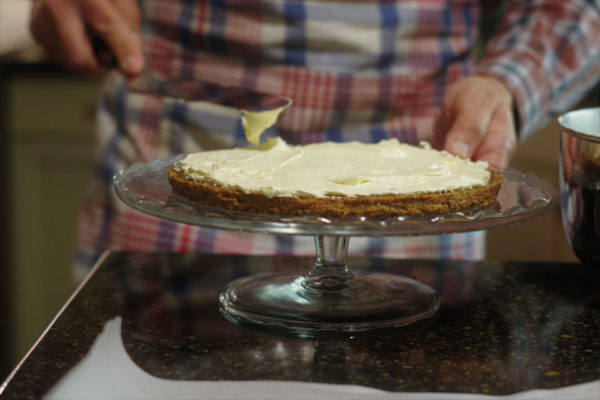
- Top it up with the walnut layer and spread another 1/4 of pastry cream on top of it.
- Follow up with the next layer, almond, and on top of it spread another 1/4 of pastry cream.
- The last layer, walnut layer, will be left just with the apricot glaze on top. Spread the remaining 1/4 of pastry cream around the sides of the cake.
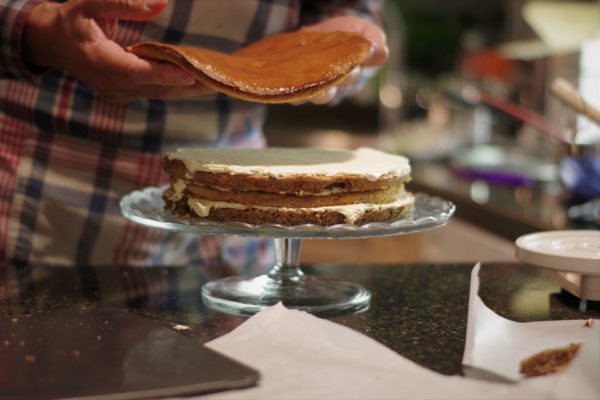
- Press the chopped walnuts on the side of the cake using an offset spatula.
- Cover and refrigerate the cake to set the glaze, about 1 hour.
- In a small saucepan, over high heat, bring sugar, water and chocolate to a boil, stirring occasionally. Reduce the heat to medium and cook stirring constantly until glaze thickens up and reaches 112°C (234°F), approximately 10 minutes. Keep an eye on a temperature and do not let it go over set 112°C (234°F) or it will turn into a candy!
- Remove from heat, stir to cool and thicken lightly, about 1-2 minutes.
- Pour the warm chocolate glaze over the top of the cake. Using an offset metal spatula make sure the cake top is coated completely.
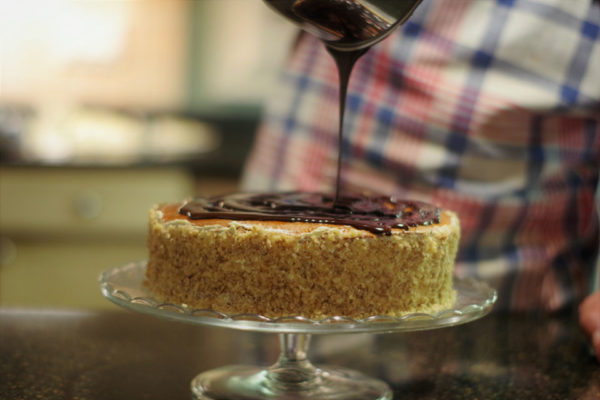
- Cover and refrigerate the cake. Serve at room temperature.
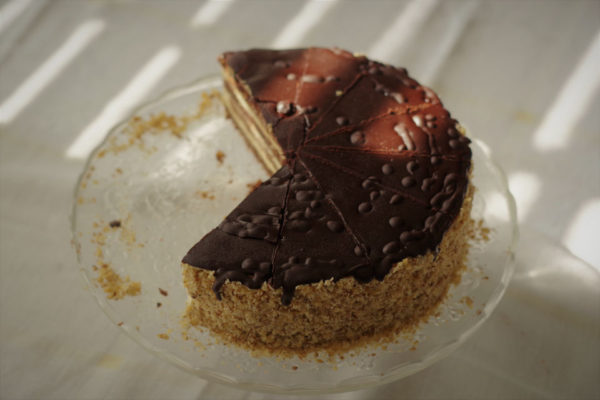

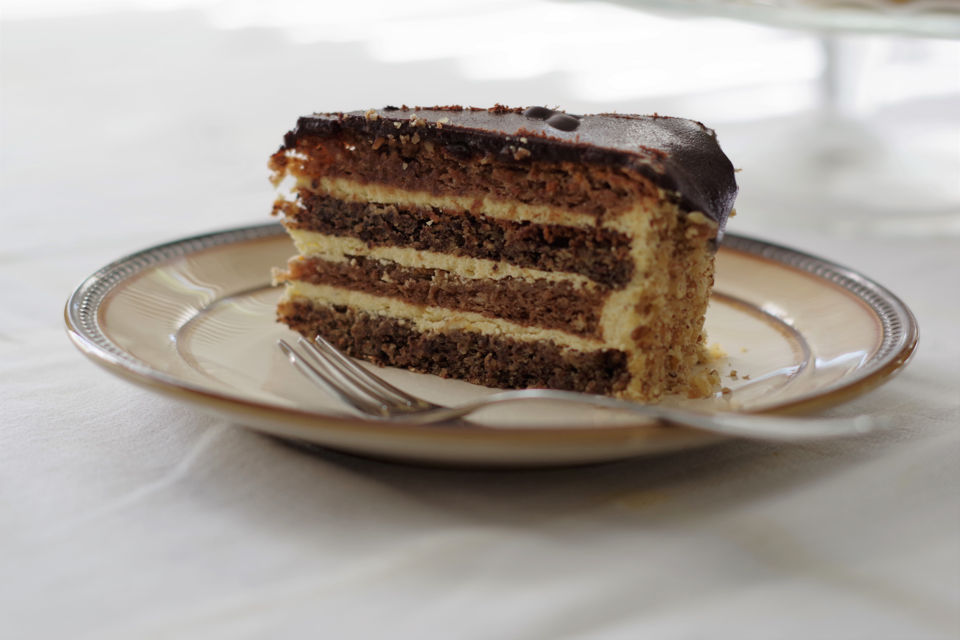
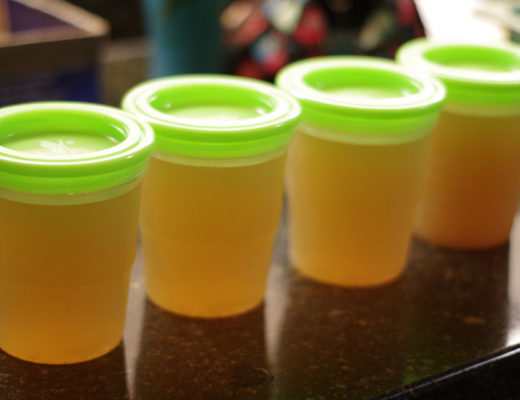
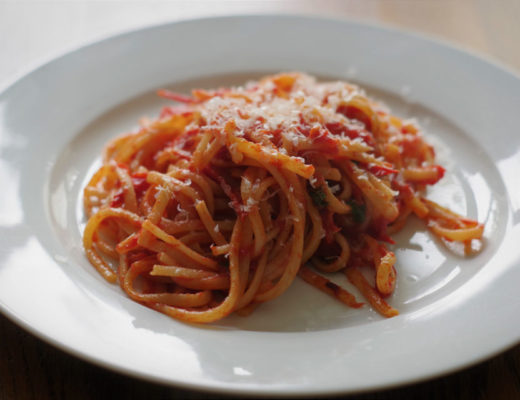
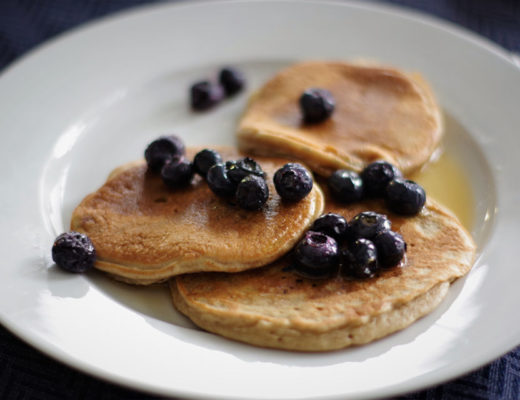
No Comments